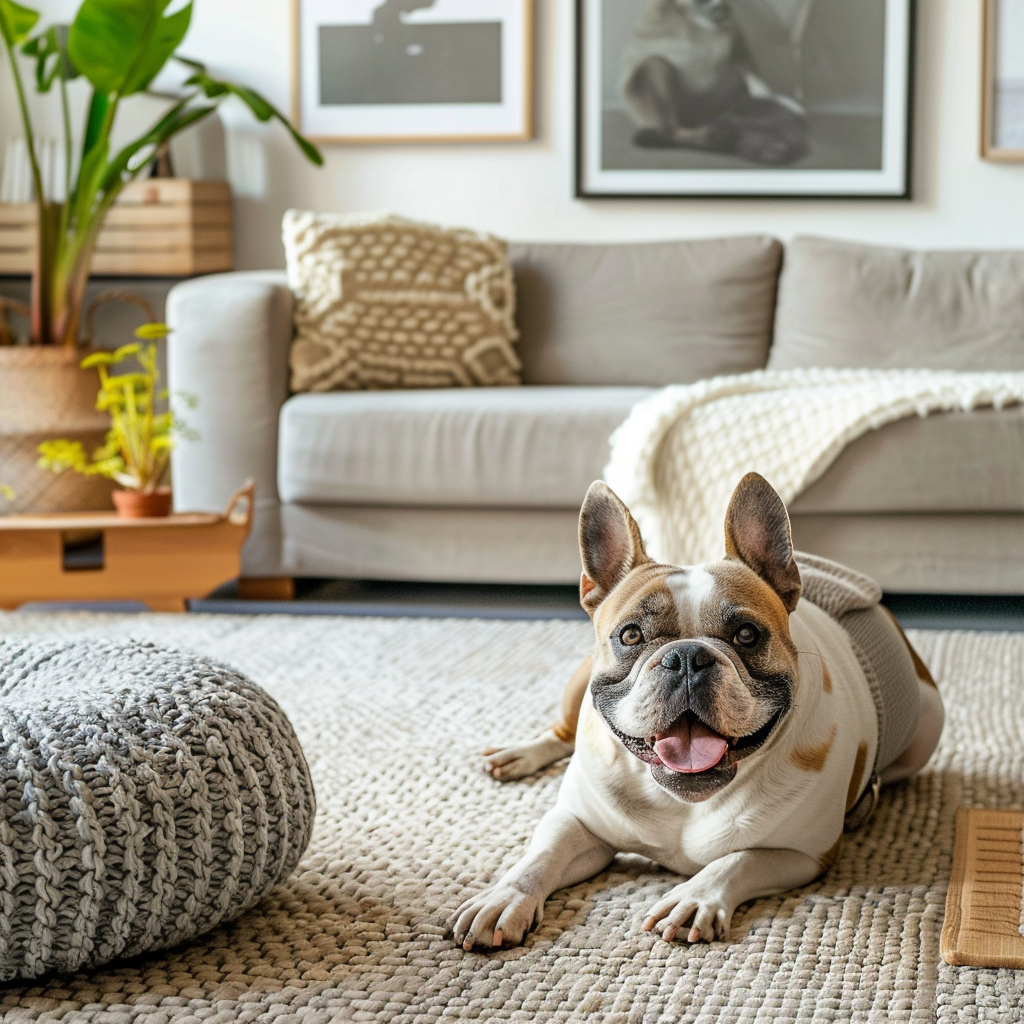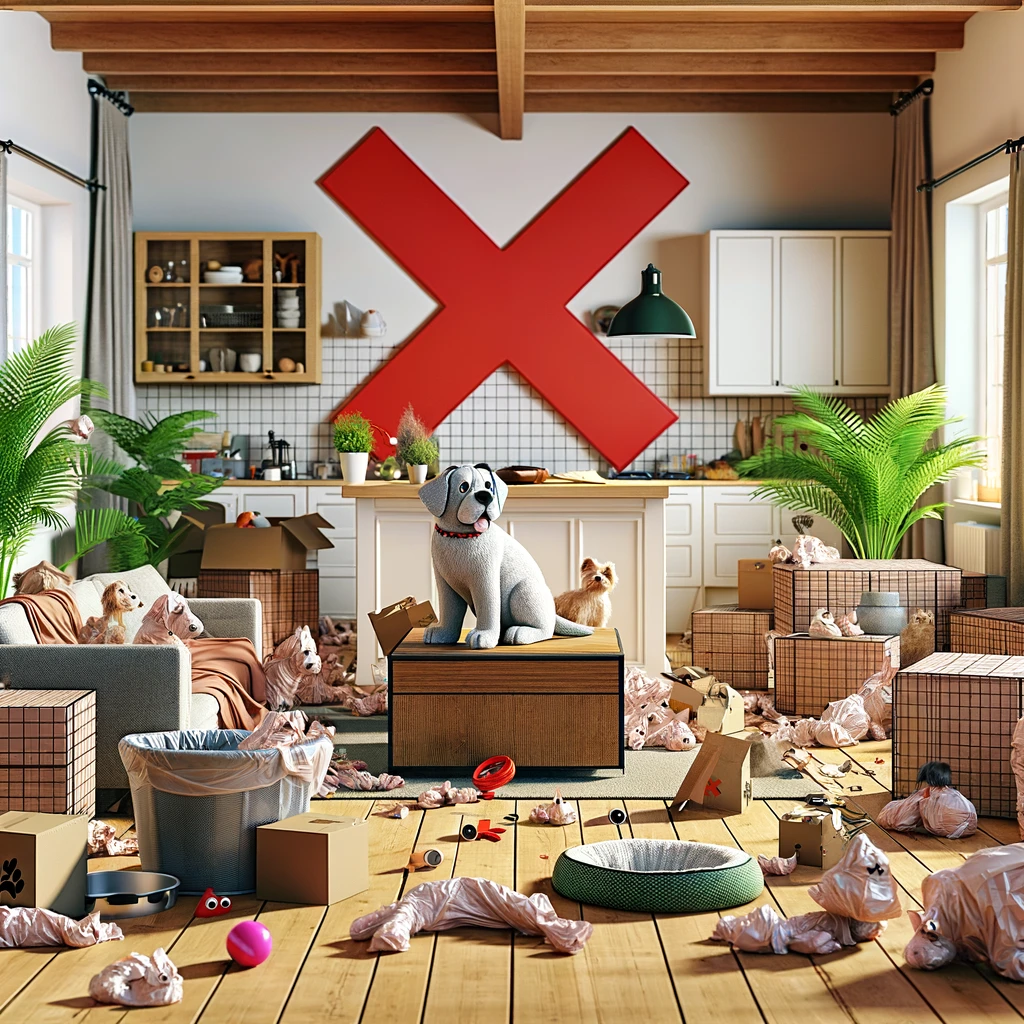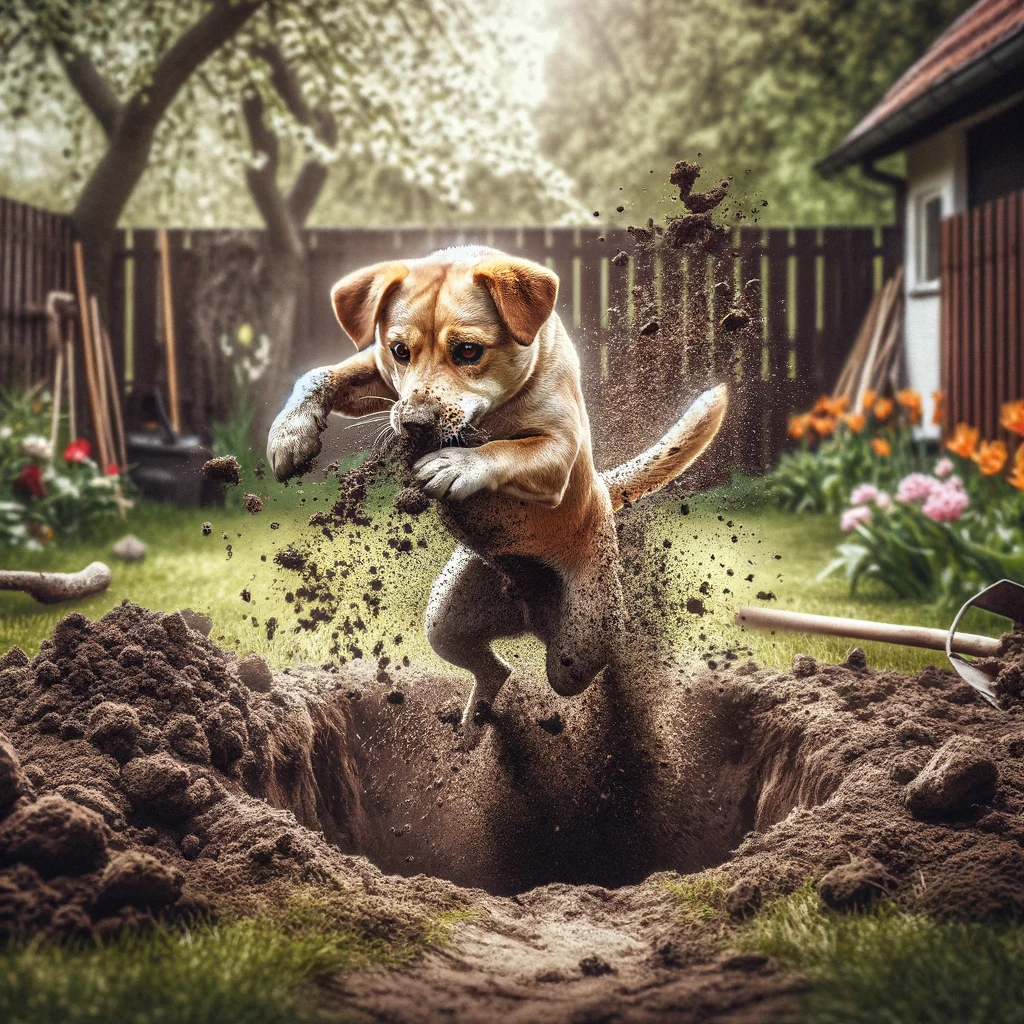Welcoming a dog into your home is like inviting a whirlwind of joy that comes bundled with a mischievous streak. Your fluffy friend might not see the difference between a chew toy and your favorite pair of shoes, which is why safeguarding your abode is a task that sits right at the top of the pet parent to-do list.
Dog proofing your house, after all, is about creating a space where your tail-wagger feels as comfortable and secure as you do, without turning your home into a scene from a detective movie where everything is a clue—ahem, a chew.

While you’re cruising on this Chew-sade, remember that every cushion is a potential cloud for your pooch to hop on and every dangling wire a mysterious serpent that must be confronted.
It’s essential to balance coziness with caution to keep the little detective happily sniffing around permissible mysteries, and not the forbidden ones.
Key Takeaways
- Home Sweet (Safe) Home: Turning your house into a fortress doesn’t mean sacrificing style. With creative solutions, you can protect your pooch and your prized possessions.
- Safety First: Whether it’s the kitchen capers or the laundry room ruckus, ensuring every corner of your home is pup-proof is crucial for their well-being.
- Creating Comfort: A cozy nook or a dedicated doggy den isn’t just about sleep; it’s about providing a secure spot for your dog to call their own.
- The Great Outdoors: Your backyard is a wonderland for your dog. Making it safe means they can explore, play, and nap in the sunshine, worry-free.
- Love and Locks: Ultimately, dog-proofing is an act of love. It’s about creating an environment where your dog feels as loved and secure as possible.
Dog Proofing Your House

You may think your home is your castle, but remember, your furry friend might just see it as one giant chew toy.
Before they declare a knightly joust with your furniture or embark on a quest to conquer your shoe collection, it’s time to fortify your domain against the mischievous antics of Sir Barks-a-Lot.
Setting Up a Safe Haven
Imagine creating a mini-castle within your keep specifically designed for your noble hound. This is where child-proof locks transform into dog-proof charms, effectively keeping your pantry safe from curious doggo food burglars.
These magical barriers will protect your delectable treats and ensure your furry friend doesn’t indulge in any unauthorized feasts.
To establish a comfy zone fit for a canine king or queen, select a plush dog bed or a cozy crate and tuck it away in a quiet corner of your home. This designated space will serve as a throne room for your four-legged monarch, providing them with a sense of security and comfort.
Unlike the drama that often unfolds in royal courts, this special retreat will be a place of peace and relaxation for your furry ruler.
Deck out their space with their favorite toys, a soft blanket, and a few tasty treats to make it a truly irresistible haven. This way, when your dog needs a break from their adventurous pursuits, they’ll have a familiar and inviting place to retire to, without causing any upheaval in the rest of your household.
By creating a safe and comfortable space for your dog within your home, you’ll not only protect your belongings from their playful explorations but also provide them with a sense of belonging and security.
Kitchen Capers

Your kitchen is the belly of the beast: where forbidden fruits (or just the taste of the trash can) tempt those roving canine noses. To keep your culinary kingdom safe from the mischievous antics of your furry friend, consider the following strategies:
- As the American Kennel Club advises, “Put away small items that are choking hazards — such as coins, paper clips, rubber bands, and jewelry — to prevent the puppy from choking on them.”
- Secure your snacks behind fortress-like refrigerator doors and invest in trash cans with childproof lids to curb any dumpster-diving escapades.
- Beware, the cords of your electronics hold the allure of a knight’s gleaming sword to a pup in chewing armor. Ensure these tempting targets are tucked away or protected with cord covers.
Laundry Room Ruckus
The laundry room, often overlooked, is a dragon’s den of dangers. Bold warriors may seek glory by munching on forbidden potions like detergent or bleach. To halt their hazardous quest and transform your washer and dryer into sanctuaries of solitude, follow these tips:
- Place cleaning products on high shelves, well out of reach of curious paws and noses.
- Shuttle any small, chewable items like socks or dryer sheets to safety, as they may resemble enticing toys to your playful pup.
- Consider installing a baby gate or keeping the laundry room door closed to prevent unsupervised access to this potentially treacherous territory.
Living Room Lairs

To protect your living room realm from the playful antics of your pup, consider the following strategies:
- Stow away enticing remote controls and tempting magazines, as these items may become the targets of impromptu chewing sessions. Remember, for your pup, chewing isn’t just a hobby; it’s a mission.
- Invest in a remote control caddy or drawer to keep these devices out of sight and out of mind.
- Place magazines and books on higher shelves or in closed cabinets to prevent them from becoming impromptu chew toys.
- Arm your coffee table with chew-resistant coasters and consider a basket for easy-to-grab toys.
- Opt for coasters made from durable materials like silicone or hard plastic, which can withstand the occasional gnawing attempt.
- Keep a basket filled with your pup’s favorite toys nearby, encouraging them to redirect their chewing instincts toward appropriate objects.
- Provide your furry friend with a designated chew toy area, complete with a soft bed and a variety of enticing toys.
- Rotate the toys regularly to keep your pup interested and engaged, minimizing the likelihood of them seeking out off-limits items to chew.
Bathroom Banter
The bathroom might seem like a no-dog’s land, but let’s face it, your tail-wagger has considered every inch of your home their kingdom—including this porcelain throne room.
Dog-proofing your bathroom involves a series of strategic maneuvers:
- Start by securing the toilet lid; you don’t want an impromptu splash zone or Fido mistaking it for a water bowl.
- Medications, lotions, and cosmetics should be stashed away, as a dog with a face full of moisturizer is a photo op but a trip to the vet waiting to happen.
- Keep all prized possessions out of paws’ reach—because unlike cats, dogs don’t gracefully drape over the sink, they launch a full-scale treasure hunt.
Guarding Against Garbage
Your kitchen garbage can is like an all-you-can-eat buffet for your daring doggo. It’s packed with discarded culinary delights and, unfortunately, toxic dangers like coffee grounds and chicken bones.
- Trash Cans:
- Secure with child-proof locks or invest in a can with a heavy lid that Lassie can’t lift.
- Consider stashing the can under the sink or behind a puppy-proofed cabinet door.
- Countertop Caution:
- Keep countertops clear of tantalizing toxins like chocolate or grapes that can make Fido’s frolic turn foul.
Pro-tip: A sprinkle of “No Chew” spray on the trash can might just save it from becoming your pooch’s personal chew toy.
By implementing these strategies, you’ll create a living room lair that is both comfortable for you and safe for your canine companion. With the right mix of prevention and redirection, you can ensure that your living space remains a peaceful kingdom, free from the destruction caused by an overzealous chewer.
Remember, the quest for a dog-proof realm never truly ends—it thrives on your wits and your pup’s chew toys.
A Cozy Nook for Sleepy Tails

In the quest for canine comfort, remember your dog’s not just looking for a place to crash; they want a snug sanctuary that smells like dreams and whispers “good boy” in their ear. Let’s set up that perfect pooch paradise!
Building a Doggy Den in your Bedroom
Ever walked into your bedroom and found Fido curled up on your pillow, eyes puppy-like but clearly plotting to take over your bed?
Well, it’s time to reclaim your space by creating a den specifically for your four-legged roommate.
Choose a quiet corner in your bedroom, away from doors and foot traffic. Slide in a dog bed that’s plush with comfort—think memory foam for those meticulous mutts who love to circle thrice before lying down.
An overstuffed blanket can add an extra layer of coziness, perfect for burrowers or dogs who appreciate a makeshift fort.
Make sure the furniture nearby is resistant to the allure of sharp paws—opt for materials that won’t look like a scratching post invitation.
Dealing with the Chew-sade

Brace yourselves, fellow pet-proofers, for the grand “Chew-sade”—the noble quest to save your home from the Jaws of Destruction (also known as your beloved canine). Before you ready your armory with chew toys and games, it’s essential to understand why your puppy feels compelled to chew and how you can effectively redirect this natural behavior.
Why do puppies chew?
- Teething: Just like human babies, puppies experience a teething phase where their gums are sore and chewing helps alleviate discomfort.
- Exploration: Puppies use their mouths to explore and learn about their environment, much like how human babies put things in their mouths.
- Boredom or anxiety: Chewing can be a way for puppies to cope with boredom or stress, especially if they lack proper mental stimulation or exercise.
How to train your puppy to stop chewing:
- Provide appropriate chew toys: Offer your puppy a variety of safe, durable chew toys that cater to their chewing instincts. This will help redirect their attention from off-limits items.
- Use positive reinforcement: When your puppy chooses to chew on their designated toys, praise them and offer treats to encourage this behavior. This will help them associate chewing on appropriate items with positive outcomes.
- Puppy-proof your home: As mentioned earlier, keep tempting items like shoes, books, and remote controls out of your puppy’s reach. This will minimize the opportunities for inappropriate chewing.
- Supervise and redirect: When you catch your puppy chewing on something they shouldn’t, calmly redirect their attention to an appropriate chew toy. Consistency is key in helping them understand what is and isn’t acceptable to chew on.
- Provide mental stimulation and exercise: A tired and mentally stimulated puppy is less likely to engage in destructive chewing. Ensure your puppy gets plenty of physical exercise and engage them in interactive play and training sessions to keep their mind occupied.
With time and effort, your puppy will learn to channel their chewing instincts into appropriate outlets, ensuring a harmonious and chew-toy-filled home for all.
Backyard Bliss and Beware

Your backyard is your pup’s outdoor kingdom, but without the right royal treatment, it can turn into a royal mess. Time for a DIY Doggie Kingdom makeover!
Securing the Green Scene
Before your furry Houdini makes a break for it, you better check that fence! Examine for gaps where your dog might squeeze through. Also, look for spots they could potentially turn into a doggy door with a bit of excavation work.
Also, those gardening tools left out? They’re not yard art. Put them away before they become impromptu hurdles or, worse, chew toys.
- Checklist for a Dog-Friendly Fortress:
- Inspect for escape routes: gaps, loose boards, or holes beneath the fence.
- Store away gardening tools and secure toxic plants out of reach.
- Ensure a fireplace screen is in place if you’ve got flames in your yard. They’re mesmerizing, but not a hotspot for snouts or tails.
Pool Party Protocols
Splash zone ahead! If your backyard oasis features a pool, then pool safety is doggone non-negotiable. Not all pups are natural Phelps, so make swimming a supervised sport.
Consider a fancy dog-friendly ramp for graceful exits. Also, never leave your dog unsupervised when the pool’s uncovered. Clear instructions, remember?
- Diving Into Dog Pool Safety:
- Do not let your dog have access to the pool unsupervised
- Install a sturdy pool cover. It’s not a trampoline, despite what your dog thinks.
- Provide plenty of water and shade on the deck for post-doggy-paddle lounging.
- Consider a pet life vest for those not blessed with buoyant bums.
The Dog House

Breath a sigh of relief – you’ve just leveled up your backyard dog-proofing. Let the tail-wagging commence!
Every dog deserves a space to call their own—a sanctuary where they can retreat, relax, and feel secure. When it comes to your furry friend’s outdoor adventures, a well-constructed doghouse can provide numerous benefits for their physical and mental well-being.
Benefits of a doghouse or kennel in your yard:
- Protection from the elements (sun, rain, wind)
- Especially important for dogs spending extended periods outdoors
- Prevents health issues related to prolonged exposure to extreme conditions
- Provides a sense of security and comfort
- Dogs are den animals and appreciate a cozy space of their own
- Reduces stress and anxiety, particularly for nervous or fearful dogs
- Serves as a safe haven when feeling overwhelmed
- Promotes better outdoor behavior
- Designated space for rest and relaxation
- Discourages destructive habits (digging, chewing on outdoor furniture)
- Convenient spot for midday naps or breaks from playtime
Selecting the right doghouse:
- Prioritize safety, comfort, and durability
- Choose a size that allows your dog to stand, turn around, and lie down comfortably
- Opt for materials that provide adequate insulation and ventilation
In the end, dog-proofing your home is more than just protecting your valuables; it’s about creating a living space that nurtures the bond between you and your canine companion. It allows your pup to be themself without worrying about their safety.
By addressing potential hazards and establishing secure, comfy zones, you ensure that your home is a haven of happiness and health for your furry friend. Happy dog-proofing!



